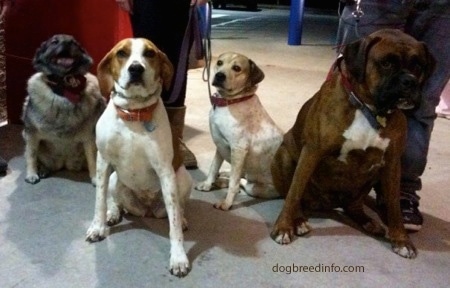
Most people realize that one should not randomly approach an unfamiliar dog that is chained, behind a fence, in a pen or kennel or in a car, as it could result in a bite if the dog is startled or defensive. The strange dogs that you must approach, including those dogs in a shelter, should not be approached head-on. Turn your body sideways and do not make eye contact. Staring directly into a dog’s eyes could be seen as a challenge. Stay calm. Limit your words. Speak less. Let your body language communicate with the dog.
But what about those dogs that you know are friendly? The ones with the owners that you asked permission to come and see?
Here is how it usually goes. Stranger approaches. "Is your dog friendly?" Owner responds, "Yes, the dog is friendly." Stranger rushes over with their hand pushed into the dog's face, speaking in an excited, high-pitched, whiny tone. Some people go as far as to start playing with the dog while the dog is on the leash.
This is the wrong way to approach a dog. It often freaks a dog out, makes it unsure, sometimes leads to dog bites or leaves the owner an over-stimulated, excited dog to contend with.
One must always look at it from the dog's point of view. Think about it, what if strangers approached you in that manner—rushed up to you with their hand in your face, talking high-pitched baby-talk? How about if a stranger ran up to you and gave you a "hello" bear hug?

It's not polite behavior on the human’s part and it makes training difficult for those owners who are trying to train their dogs to have good dog-to-human manners by not jumping or rushing at humans. All of the excitement makes the dog jump around. Owner tells the dog to calm down and the stranger tells the owner it is OK, they don't mind if the dog is excited or jumps. However, dog owners who understand dog behavior will mind. It makes it very difficult to train a dog to have good public manners when the humans are constantly approaching in this manner.

Do not rush up to the dog putting your hand in the dog's face. A dogs sense of smell is about 1,000 to 10,000,000 times more sensitive than a human’s (depending on the breed). You do not need to stick your hand out to a dog; the dog can already smell you from a distance. Sticking yourself in front of a dog like that is rude human-to-dog behavior and it often makes the dog unsure about you.
It is not wise to hug an unfamiliar dog. For a human, hugging is an act of love, however to a dog it can be seen as a dominance challenge as you wrap your body around the dog. Even dogs that are normally friendly can often misinterpret the act of a human hug.
Saying "hello" and petting the dogs you see out in public is great. Most dogs and owners both enjoy it. However one needs to always keep good human-to-dog manners in mind. Always ask the owner for permission before you approach a dog.
The proper way to greet a dog is to turn your body sideways with no eye-to-eye contact. Do not reach for the dog but rather allow the dog to take a few steps towards you and smell you. Stay calm and as tempting as it is, avoid speaking in an excited, high-pitched, whiny tone. You may then calmly pet the dog. Pet the dog gently and avoid getting the dog excited as it only makes it harder for the owners to carry on after you walk away. That is greeting a dog in dog language in a non-confrontational way and respecting both dog and owner.
Written by Sharon Rose © Dog Breed Info Center ® All Rights Reserved
